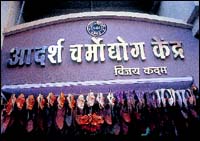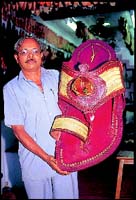


|
|
|
They've been spotted down runways from Milan to Mumbai, reached the White House and made an appearance at Selfridges of London. Madonna owns a pair or two and Imelda Marcos probably has one stashed away in her endless collection of fancy footwear. They're not Monolo Blahniks or the likes but our very own desi Kolhapuri chappals. Tried, tested and perfected over 400 years, the chappals have evolved from basic footwear, a simple wooden base and toe similar to that worn by sadhus. Today, shops like the Adarsha Charmodyog Centre in what's popularly known as Chappal Galli have over 85 different styles to choose from. The owner Vijay Kadam hails from a long line of Kolhapuri chappal experts. The fourth generation to continue in the trade. His great-grandfather once taught in a shoe factory sponsored by the then Shahu Maharaj and Kadam today runs Kolhapur's oldest chappal centre, established in 1935.
The durable and strong hide from the tail is used in the stitching that follows. Once the stitching stage is done, the sole is re-embossed and the chappals oiled to increase their strength and coolness. Castor oil is best for the process although any vegetable oil apart from coconut oil, which makes the chappals stiff, can be used. The upper straps are then made according to size and decorated with colourful tassels before the final colour coat is applied.
Chappals also vary in weight from 100 gm a pair to a rather bulky 2 kg. Touted as the world�s thinnest and lightest footwear, the bed to bath 100 gm chappals can be rolled into a tiny pouch to fit into your trouser pocket. The broad senapati chappals are also on the heavy side. They are oiled with groundnut oil and their hollow soles filled with the vinchu seed, which gives a crackling noise with every step, a clever little addition to the shoe originally meant to scare off snakes as soldiers trekked through forests.
Adarsha Charmodyog Centre: 302C Shivaji Market. 0231 - 2547067
|

Home Page
About the mag
Subscribe
Advertise
Contact Us

 Kolhapur�s Sole!
Kolhapur�s Sole!
 The chappal making process is a time consuming one and it can take one skilled worker from three hours to up to one day to make a pair. The entire process is still done by hand with the procedure starting with the tanning stage that lasts 21days. Either buffalo or cowhide brought in from Chennai is used, with one hide sufficing for 20 pairs of chappals. The hide is first soaked in water and bleached for a week in a calcium solution to remove the hair. It is then left to hang and expand after which it is cut to shape. The pressing-seasoning process then reduces the thickness of the leather and is followed by templating, which gives the chappal its final shape.
The chappal making process is a time consuming one and it can take one skilled worker from three hours to up to one day to make a pair. The entire process is still done by hand with the procedure starting with the tanning stage that lasts 21days. Either buffalo or cowhide brought in from Chennai is used, with one hide sufficing for 20 pairs of chappals. The hide is first soaked in water and bleached for a week in a calcium solution to remove the hair. It is then left to hang and expand after which it is cut to shape. The pressing-seasoning process then reduces the thickness of the leather and is followed by templating, which gives the chappal its final shape. The colours like the chappals themselves vary from your traditional shades of beige and brown and red and black to gold and silver. If you have time on your hands though it might be worthwhile ordering a custom-made pair in almost any colour you like. What's currently in vogue in Kolhapur's Chappal Galli is footwear with no middle strap, although as Vijay Kadam explained, fashion fads are fickle and if you want to play it safe in the Kolhapuri chappal fashion department the traditional chappal design is still the best.
The colours like the chappals themselves vary from your traditional shades of beige and brown and red and black to gold and silver. If you have time on your hands though it might be worthwhile ordering a custom-made pair in almost any colour you like. What's currently in vogue in Kolhapur's Chappal Galli is footwear with no middle strap, although as Vijay Kadam explained, fashion fads are fickle and if you want to play it safe in the Kolhapuri chappal fashion department the traditional chappal design is still the best. This age-old traditional Kolhapuri trade is also comfortable and modern enough to use today. Worn by everyone from the Maharaja of Kolhapur to the city's vegetable vendors, the chappal is versatile footwear amongst Kolhapuris who often wear it no matter what the occasion. It is durable and snug to use, propagated by ayurveda for its cooling effect on the feet and won't pinch your pocket, ranging in price from Rs.75 per pair to Rs.525. What was once your no frills footwear is now quite de rigeur.
This age-old traditional Kolhapuri trade is also comfortable and modern enough to use today. Worn by everyone from the Maharaja of Kolhapur to the city's vegetable vendors, the chappal is versatile footwear amongst Kolhapuris who often wear it no matter what the occasion. It is durable and snug to use, propagated by ayurveda for its cooling effect on the feet and won't pinch your pocket, ranging in price from Rs.75 per pair to Rs.525. What was once your no frills footwear is now quite de rigeur.